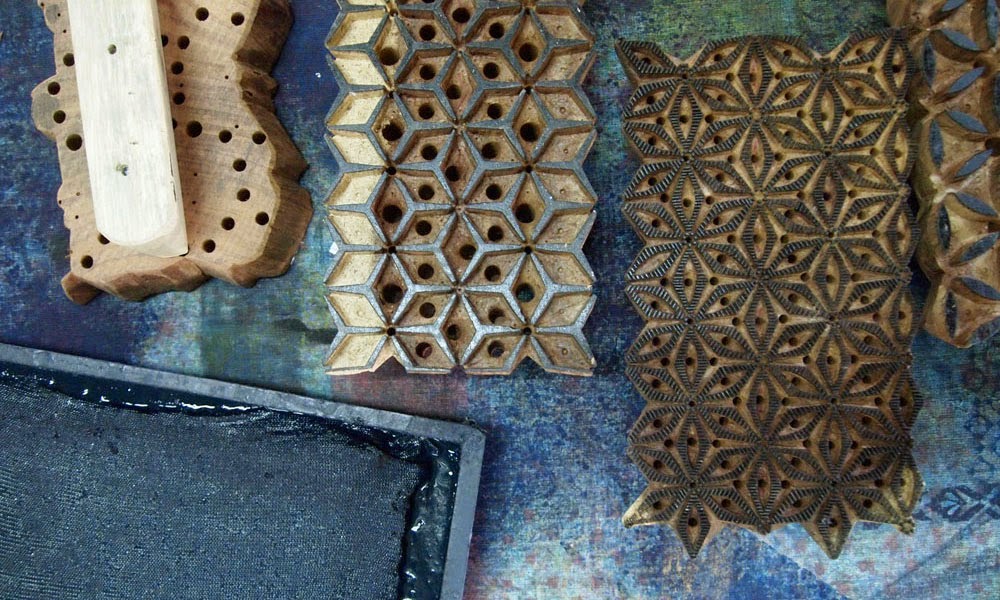Indigo: A Block-Printer's Best Friend.
Indigo hand-block prints have continued to stay in vogue ever since the 18th century, when they were first discovered. The Indian ethnic wear industry loves indigo prints in all kinds of traditional and contemporary designs. These prints have the ability to lend a modish versatility to any fabric and are absolutely sublime. No wonder everyone loves them!
There aren’t many textile manufacturers in India who still invest time in processing natural indigo and creating block-print fabrics. But there is one part of the country where both these processes continue to thrive: the cultural hub- Rajasthan.
In Rajasthan, you will find manufacturers still creating rich, handcrafted indigo block prints using time-tested techniques. These prints are translated onto fabrics to create beautiful ethnic wear for both women and men.

The Process of Indigo Hand-Block Printing
The process of creating indigo block-prints starts with soaking indigo plant bundles. This helps extract the beautiful vibrant dye. Simultaneously, long cotton sheets are laid out to absorb the color.
Hand-carved wooden blocks are used for applying a wax resist to the cotton fabric. Once the fabric has been dyed, the areas with the wax application, continue to remain white and the rest of the sheet takes on the dynamic hues of lapis lazuli, cerulean and midnight, all originating from the exotic indigo plant.
Indigo hand-block prints look stunning on a variety of different cotton fabrics including cotton jacquard, khadi cotton, linen, handloom cotton and cotton checks. They are a popular choice of prints for Indian ethnic wear such as kurtas, salwar-kameez, skirts, palazzo pants, dupattas and various other styles.

Indigo Hand-Block Printing Techniques
Different designers use different techniques for hand-block printing. The popular ones include ‘bagru’ or vegetable and natural dye-based printing, mud resist or ‘dabu’ printing, kalamkari printing, block kalamkari prints, hot discharge printing, tie and dye, jwata printing (combination of dabu and bagru prints) and several others.
Bagru prints are extremely popular and have an exceptional quality that sets them apart from other printing techniques: they are eco-friendly. Several designers are looking to enter into the eco-friendly business space and this is what makes bagru printing appealing to them. Till date, artisans make use of traditional vegetable dyes to print the cloth. In indigo printing specifically, the blue color naturally comes from the indigo plant. You will find that bagru prints usually have floral ethnic patterns and are therefore used extensively in designing women’s Indian clothing. This type of block printing originates from Rajasthan.

The raw materials used in ‘Mud-Resist’ or Dabu printing are as timeless as the craft itself. These raw materials are nothing but water and mud. The same materials were used for creating the prints back in 8th century AD. One of the most popular Indian wear that adorns this print is the ‘Ghagra’ from Rajasthan. The women of Rajasthan, also called ‘Fetiya’ in the local language, love wearing this flowing garment. The Ghagra is typically combined with a long fabric called a ‘Bandhej Lugda’ and this is worn over the head.
Why Indigo Fabrics Bleed
Most people have experienced the characteristic fading or bleeding of the indigo fabric, as seen on their kurtas or favorite pair of jeans. Why does indigo printing tend to bleed or fade? Well, this is primarily because indigo will not actually form a chemical bond with the fabric into which it is dyed. It ends up becoming insoluble again when put into water. By reacting with air, it tends to get accumulated in the tiny spaces within the fiber. With the passage of time, the rubbing of the fibers causes some of the blue dye to wear off and this creates faded lines.

“Crocking” is another common concern around indigo dyed fabric. It basically involves rubbing off of the dyed fabric color on other clothing or things, if not correctly laundered prior to use. Manufacturers usually suggest washing indigo hand-block prints in hot water and using commercial dye fixatives to prevent bleeding or crocking.
With summer fast approaching, you might like to pick out your favorite prints from our exclusive indigo hand-blocks collection that features high-quality printing in unmatched designs!







